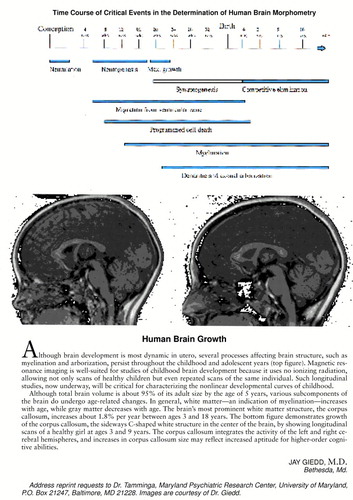Brain Development, IX
Although brain development is most dynamic in utero, several processes affecting brain structure, such as myelination and arborization, persist throughout the childhood and adolescent years (top figure). Magnetic resonance imaging is well-suited for studies of childhood brain development because it uses no ionizing radiation, allowing not only scans of healthy children but even repeated scans of the same individual. Such longitudinal studies, now underway, will be critical for characterizing the nonlinear developmental curves of childhood.
Although total brain volume is about 95% of its adult size by the age of 5 years, various subcomponents of the brain do undergo age-related changes. In general, white matter—an indication of myelination—increases with age, while gray matter decreases with age. The brain’s most prominent white matter structure, the corpus callosum, increases about 1.8% per year between ages 3 and 18 years. The bottom figure demonstrates growth of the corpus callosum, the sideways C-shaped white structure in the center of the brain, by showing longitudinal scans of a healthy girl at ages 3 and 9 years. The corpus callosum integrates the activity of the left and right cerebral hemispheres, and increases in corpus callosum size may reflect increased aptitude for higher-order cognitive abilities.
Images are courtesy of Dr. Giedd.

Time Course of Critical Events in the Determination of Human Brain Morphometry



